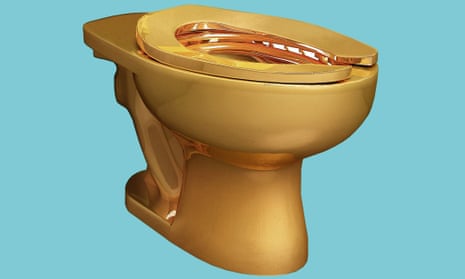While the poor get poorer, the rich even get to do their crap on a golden toilet.
No, this is not the latest speech by Bernie Sanders, driven to Swiftian scatology by his defeat in the New York primary. It is a trenchant comment on wealth and luxury on Manhattan’s Upper East Side. Or Upper East Backside.
The Solomon R Guggenheim Museum at 1,071 5th Avenue is soon to install a toilet made of 18-carat solid gold. It’s both a work of art and a working receptacle for human waste. How’s that for interactive art? And everyone who makes use of this public facility (the Guggenheim expects queues) will participate in its Italian creator, Maurizio Cattelan’s none too subtle comment on the obscene wealth of the art world and the wider society beyond.
The Guggenheim was the first place I ever saw faeces presented as art. I was ascending its circular ramps, feeling slightly bored by an exhibition of post-war Italian art, when I came across a small tin can bearing the label “Merda d’artista”. A closer read confirmed this was, indeed, a can of the artist Piero Manzoni’s excrement.
Oh for those innocent days in the early 1990s, when it was still possible to be astounded by a can of poo in a museum. Today, every art student knows all about Manzoni: the Tate catalogue bluntly titles his most famous work “Artist’s Shit”. Even people who know nothing else about art know that Marcel Duchamp changed it for ever when he tried to exhibit a urinal in an exhibition. Next year is the centenary of Duchamp’s Fountain.
So the point of Cattelan’s facility is not its profanation of the art museum with base human functions. That’s all been done before. Or even his work’s practicality. Sarah Lucas exhibited a plumbed-in toilet at the Royal Academy in London two decades ago. It’s the fact that this one is so expensive. Guards will be posted to deter thieves. This, truly, is a throne. And as they sit on this luxurious item, many may ask themselves – is this the only gold crapper on the Upper East Side?
The absurd prices paid for art, of which a golden toilet is a pungent symbol, make visible the excess and inequality that scar our society. Both Sanders and Donald Trump appeal in different ways to those outraged by the outlandish economic disparities that the Panama Papers have shown to be all too real. Even after the recent revelations about offshore tax havens, I can still think of no more glaring and monstrous image of the distorted economics of 21st-century capitalism than the grotesque art market where, as Cattelan’s fellow art star Damien Hirst has put it, “cunts sell shit to fools”.
And yet, the real miracle of contemporary art is not that it is bought and sold for lunatic prices by oligarch collectors. It is that you and I also find meaning in it. A luxury object sold for obscene amounts is at the same time a popular phenomenon that draws crowds to galleries. Art is both an investment for the 1% and entertainment for everyone else. If we could understand this paradox we might understand how 21st-century capitalism gets away with so much.
Optimistic radicals who believe in Sanders, Jeremy Corbyn and some kind of socialist revolution need to go and sit on Cattelan’s toilet and have a long think. Something does not add up in their theories. If everyone is massing in rage against a capitalism gone mad, how come people still go to contemporary art exhibitions? How come we gladly look at art that costs millions and enjoy it, instead of trashing these billionaires’ toys?
Can it be that we all buy more deeply into the culture of capitalism than we acknowledge to ourselves? Perhaps this is a philosophical toilet, after all.
Give me some privacy, please, I’m trying to think in here.


Comments (…)
Sign in or create your Guardian account to join the discussion